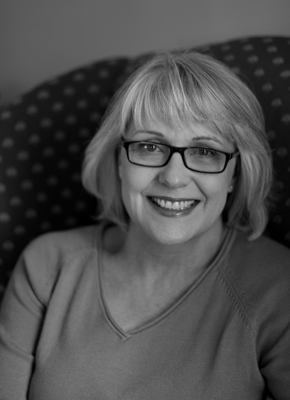 Joanne Friar grew up in New Bedford, Massachusetts, an old New England city full of 19th century mills and fishing boats. She earned her Bachelor of Fine Arts degree from the University of Massachusetts/Dartmouth where she studied illustration and photography.
Joanne Friar grew up in New Bedford, Massachusetts, an old New England city full of 19th century mills and fishing boats. She earned her Bachelor of Fine Arts degree from the University of Massachusetts/Dartmouth where she studied illustration and photography.
She has been creating art for children’s books for over 18 years, researching history and nature from ancient civilizations to the Great Depression, from wetlands conservation to endangered species. Her books have won awards such as the CBC Notable Social Studies Book, the CBC Outstanding Science Book, and John Burroughs Nature Books for Young Readers.
She is a member of the Society of Children’s Book Writers and Illustrators and the Picture Book Artists Association. Joanne and her family make their home in Somerset, Massachusetts.
Some of Joanne’s clients are Charlesbridge Publishing, Lerner/Millbrook Press, McGraw Hill, Pearson, Harcourt Educational, The Quarasan Group, Houghton Mifflin Educational, Scott Foresman, Bill Smith Studios, Richard C. Owen Publishers, Magination Press, Ladybug Magazine and Kalliope Audiobooks.
Here is Joanne explaining her process:
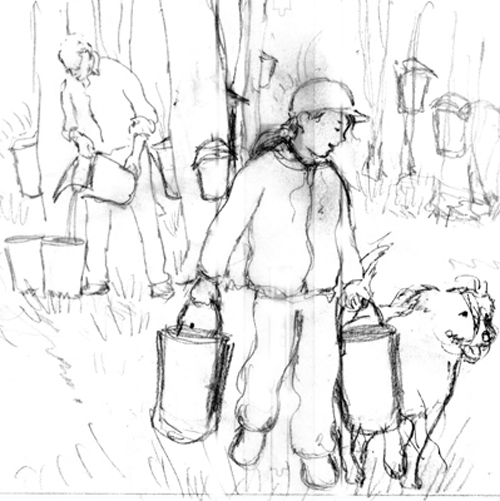
I usually start off by making some very loose thumbnail sketches, mainly for composition and text placement. When I’ve decided on the best option, I sometimes scan that thumbnail and enlarge it to the right size in photoshop. Each element in the sketch can be adjusted this way, larger or smaller, and moved around to get the best results.
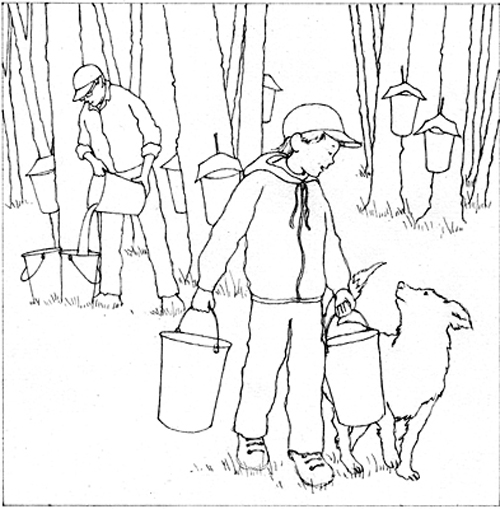
I then make a neater tracing, making final changes, and transfer the drawing onto watercolor paper using a lightbox. My favorite paper is Fabriano Artistico soft press, which is a cross between hot and cold press. It’s a little more forgiving than hot press, but the texture still allows for the detailed work that I like to do. The biggest change in this sketch was to have the dog looking up at the boy, which I thought showed that closeness between them.
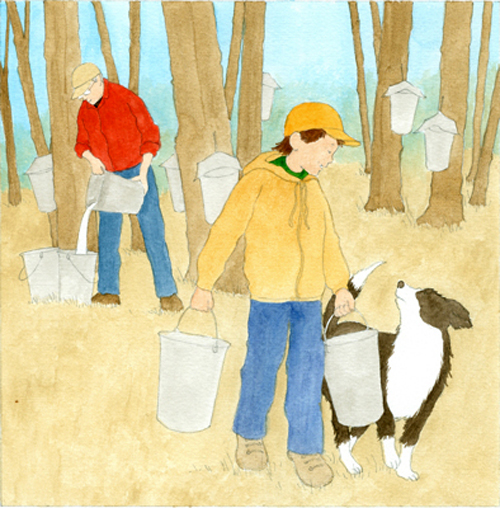
The next step is to do a light washy underpainting . I usually have an idea of what colors I want to use, and this is like doing a color study, without being totally committed to my choices. I use a combination of liquid acrylics and acrylic gouache.
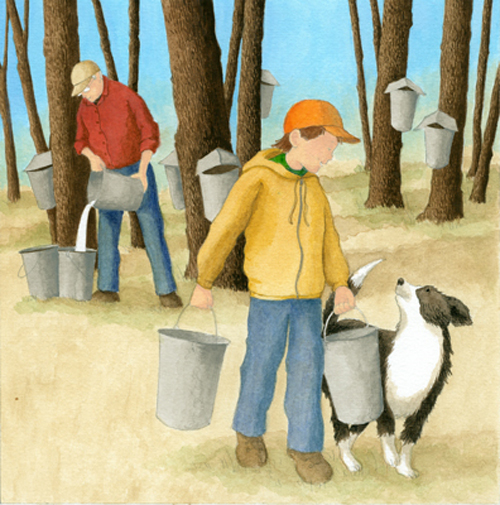
I then start to darken the elements in the picture, painting in shadows and adding details. The colors are built up slowly, layer by layer.

At this stage, I’m just about done. More details are added – grass, fur, branches, clouds, a plaid shirt. Some areas can be lightened or made deeper. The overall effect that I’m trying to achieve is a richness of color and texture.

written by C.H. Colman – Charlesbridge 2006

written by Jacqueline Farmer – Charlesbridge 2010

written by Brian J. Heinz – Lerner/Millbrook 2006

written by Marlene Targ Brill – Millbrook Press 2001
NCSS/Children’s Book Council Notable Social Studies Book

written by Meghan Nuttall Sayres – Millbrook Press 2002
NSTA/Children’s Book Council Outstanding Science Trade Book K-12
John Burroughs Nature Books for Young Readers 2002

written by Ann Purmell
Millbrook Press 2002

What was the first book you illustrated?
Sarah and Puffle by Linnea Mulder (Magination Press 1992).

How did you get that contract?
I compiled a list of small publishers from Children’s Writers and Illustrators Market and sent them photocopies of my work. About six months later I got a call from an editor with an offer to illustrate a picture book with black and white interior pictures. That was a glorious day! My first trade book offer came two days after a SCBWI portfolio critique with the art editor from Millbrook Press. That was published in 2001.

Is it more lucrative to illustrate a commercial picture book vs. doing illustrations for an educational publisher?
Educational publishing has been the bread and butter for a lot of children’s illustrators. You earn a flat fee but the pay per page is usually very good. With trade books you receive an advance and royalties if the book sells well and stays in print long enough. It’s been good for me to have a combination of both.

Since you have been illustrating books for 18 years, have you seen any changes in the industry?
It’s amazing how much computers and the internet have changed everything.

Is it harder today to get started?
There’s so much more available information out there today to help you get started. SCBWI and The Purple Crayon are the best resources. Publishers post their submission guidelines on their websites. Blogs, Facebook, Linked In make it so much easier to connect and show your art. Probably the biggest problem is a lot more competition now from all over the world.

Was there more money being paid 18 years ago?
In my experience it’s been pretty much the same. The last few years have been tough because of the recession but hopefully things have started to pick up.

Do you feel that your style has changed over the 18 years?
I like to think it has gradually evolved. Every time I start a new assignment I’m determined to improve my drawing, the composition, the color, the technique. It always looks like my “style”, but if I compare it to work I did years ago, it is a big change.

Have you changed the materials you use over the years?
I started out with colored pencils or pen and ink on Stonehenge paper. I’ve used gouache on hot press watercolor paper. Now my favorite medium is acrylic paint (for its versatility) on Fabriano soft press watercolor paper, a cross between hot and cold press.

You mention that you adjust the size of your sketch in Photoshop and change placement of objects if needed in Photoshop. When you are done painting, do you clean up your illustration with Photoshop, too?
Art for my educational work is submitted digitally. Each piece is scanned and then I adjust the levels in photoshop, which improves the color and contrast if the scan looks washed out. If there are any spots on the file from the scanner, I can get rid of them with the eraser or clone tools. When I illustrate a trade book, all of the original art is mailed to the publisher, but I’ll scan each piece at a high resolution before I send it.

You mention using a Lightbox. What size Lightbox do you use? Do you think size matters? Are there any things new illustrators should avoid when buying a Lightbox?
I use a 12” x 18” Artograph LightTracer II with a slanted surface that I’ve had for years. My first lightbox was 9” x 12”, heavy and small. The surface wasn’t slanted and I found it awkward to use, besides being too small for picture book spreads. Before that, I’d tape my sketch on a sunny window and trace away!

Do you ever use a graphic tablet? If so, which one?
I’ve recently acquired a medium sized Wacom Intuos 4 which I’ve been playing around with. I haven’t used it for any assignments yet. I’ve got a lot more to learn and that’s my goal for this year!

Do you find that you do a lot of reference work before you do an illustration for an educational publisher?
Sometimes the editor will send along links, especially if it’s for a history or science piece. And I’ll always look for my own reference materials. I have actually done a lot more research for my non-fiction trade books. O Christmas Tree covered ancient and medieval celebrations, the history of holiday decorating and Christmas tree farming. I visited an apple cider mill for one book and photographed local 19th century mills for another. Everything is checked for accuracy by the editor. Research is one of my favorite parts of the job.

How long have you been represented by Christina Tugeau?
Chris has been my rep for about 8 years.

How did you meet Christina and get her interested in repping you?
I attended a portfolio workshop that Chris was presenting at Rhode Island School of Design. She looked at my portfolio and I was invited to join the CAT group.

How many hours do you spend illustrating each week?
That’s tough to say. If I’m working on an educational job, it’s pretty much full time. There is a very fast turnover to complete sketches and then final art. Trade books allow for more flexibility. There’s a lot more back and forth between the artist and editor, but I have to manage my time well. Some days I may work all day and into the night, other times grab a few hours in between chores. Our youngest of four children has just started college, so I’m getting used to the luxury of uninterrupted time.

Do you have a schedule that you follow?
I get up early and walk with my neighbor and friend who is also a children’s book illustrator. An ideal day is working from 10 to 4 with a break for lunch. If I have a deadline, I may work after dinner. Of course schedules get interrupted with laundry and cooking and family, so I’m pretty flexible. It’s extremely important to meet deadlines.

I like the detail that you put into each of your illustrations. It must take you longer to include that detail. Do the publishers understand that and give you additional time for an assignment?
I’ve never had that discussion with any editor. For educational work, they’ll give you the deadlines for sketches and final art and you decide whether you can get the work done in the allotted time before accepting the job. Trade books might have a little more leeway because there’s a lot more work involved over a longer period of time.

Have you ever thought about writing and illustrating your own book?
I’ve written two unpublished stories, mainly because I loved the subjects and had all these pictures in my head that I wanted to illustrate. The first one didn’t have much of a plot, but produced some good portfolio pieces that led to picture book contracts. The second book is still being revised, though I have a finished dummy. (The binoculars picture is from that story.) I guess because I’m an artist the illustration ideas come first and the words grow from there.

Do you still spend time marketing yourself, even though you have an artist rep.? If so, what type of things do you do?
My rep does most of the marketing, sending out flyers, visiting publishers, and e-mailing clients with samples and reminders. I will be submitting art for next year’s Directory of Illustration and currently have work on their website. I belong to Picture Book Artists Association where members have the opportunity to submit a new piece on that site four times a year. I have a portfolio on the site for the Freelance Artists Network, a group of artists that gets together monthly from the Rhode Island/Massachusetts area. I also have a blog that I use as my personal website, making it easy to update the art.

Which illustration is your favorite?
The picture of the two boys (one with binoculars) looking up at the sky.

Can you share anything that has helped you and might help other illustrators become successful?
The first thing would be to join SCBWI. Attend conferences and workshops where you can meet editors and other illustrators and just make friends with people who have the same interest in children’s books. Check out Harold Underdown’s Purple Crayon website, which has an answer for any question you might have about children’s publishing. Don’t give up. We’re all in this because we love to create art, so keep drawing!

Thank you Joanne for sharing your process and journey. I enjoyed exploring your artwork and know you will continue your success in the future. You can see more of Joanne’s Illustrations at: http://www.joannefriar.blogspot.com/ Hope everyone will leave Joanne a comment about her illustrations.
Talk tomorrow,
Kathy
Joanne is very talented. I really enjoyed browsing though her illustrations post within this blog. Some of the illustrators I see today are wonderful, Joanne being one of them. Hopefully, one day my stuff will be out there. Time will tell. In the meantime, I hope Joanne continues to find success with her illustrations.
LikeLike
By: orples on March 10, 2012
at 12:51 am
Thanks so much for your nice comments. Hang in there and keep doing what you love!
LikeLike
By: joannefriar on March 10, 2012
at 9:31 pm
Orples,
I hope that for you too.
Kathy
LikeLike
By: kathytemean on March 12, 2012
at 9:03 pm
This is really beautiful artwork and I KNOW I’ve seen your work before, Joanne…certainly in magazines! I adore hearing about an artist’s process and this is the second time I’ve heard mention (on Kathy’s blog) of Fabriano’s soft watercolor paper. I made note of it again and plan on trying it 🙂 So thank you for that.
And although I enjoyed all these pictures, two actually made me go “Oooooo…” …the candlelit attic bedroom and the hilly farmland. Breathtaking! Thanks, Joanne and Kathy! 🙂
LikeLike
By: :Donna Marie on March 10, 2012
at 1:43 am
Thanks, Donna. I also noticed that the texture of the paper doesn’t show up when I scan it, either.
LikeLike
By: joannefriar on March 10, 2012
at 9:34 pm
Donna,
I don’t know how you can choose. I finally decided that Joanne’s favorite is my favorite, too. But I’m sure I could look again and pick another one, since they are all so good.
Kathy
LikeLike
By: kathytemean on March 12, 2012
at 9:02 pm
What fabulous work, Joanne. Your attention to detail if phenomenal. In a perfect world, you would be financially rewarded for all that extra attention! (sigh)
Thanks for sharing your background, process, and many insights. A great interview.
Cheryl
LikeLike
By: Cheryl on March 10, 2012
at 1:26 pm
Cheryl,
Thanks for leaving Joanne a comment. I am sure she appreciated it.
Kathy
LikeLike
By: kathytemean on March 12, 2012
at 8:59 pm
Thank you, Cheryl! And thanks, Kathy!
LikeLike
By: joannefriar on March 10, 2012
at 9:36 pm
Joanne,
Loved showing you and your talent off. I wish you much success in the future.
Kathy
LikeLike
By: kathytemean on March 12, 2012
at 8:58 pm
Joanne,
Thank you for sharing your process and experiences. I can’t believe I haven’t seen this link yet…you came up when I was doing New Bedford research. Beautiful drawings. I must show my children.
Paula
LikeLike
By: Paula BIrd on April 28, 2014
at 11:03 pm